17 July 2024
The Migrant Map: a decade of silent tragedies
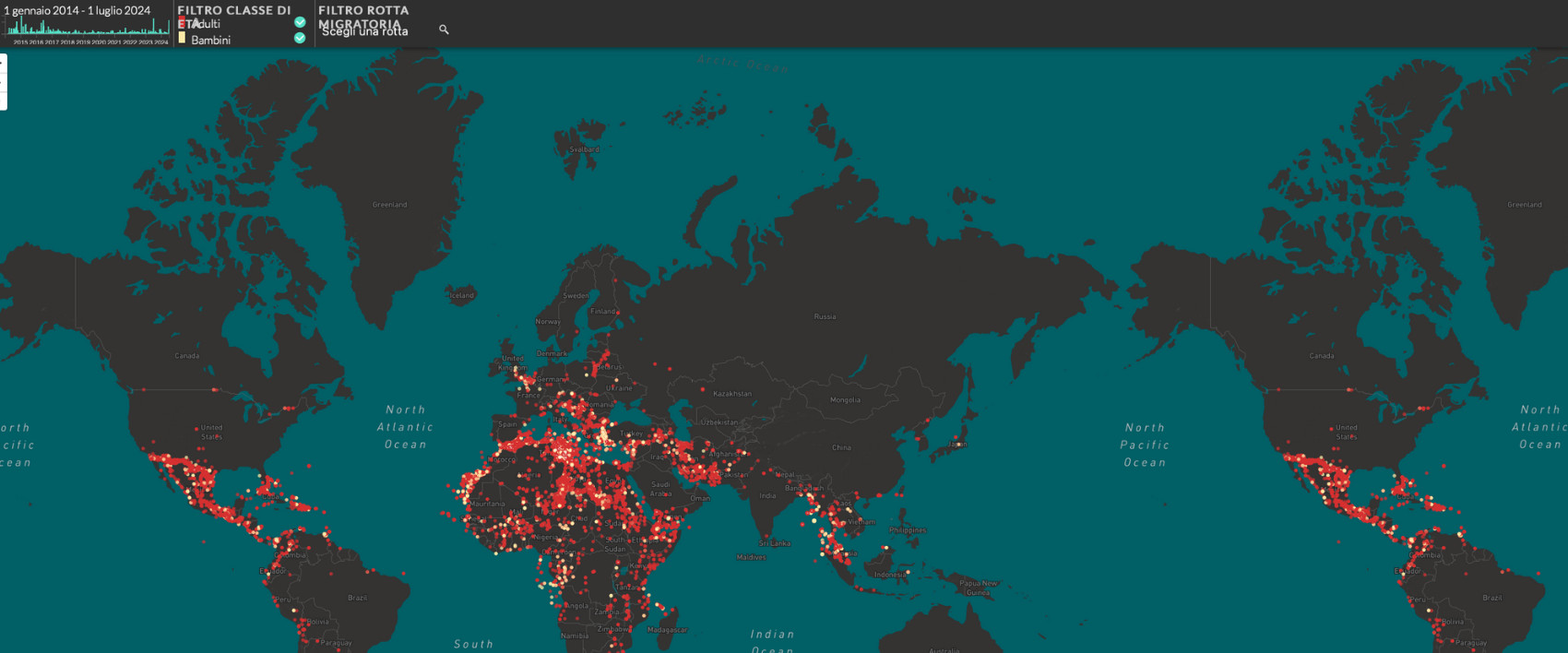
Thousands of red dots scattered across the sea, on land, between borders, or in the desert. This is the “Migrant Map”created by the Luiss Data Lab research center, directed by Gianni Riotta and Professor Livia De Giovanni. This interactive document represents the global migration phenomenon over the past decade. From 2014 to 2024, 66,760 deaths or disappearances among men, women, and children have been recorded due to adverse climatic conditions, drownings, wars, and violence. Click HERE to view it.
Thanks to data from the Missing Migrants portal and the collaboration of innovative companies like Catchy, led by CTO Alessandra Spada, the dramatic reality of migration routes has been reconstructed using Geo Intelligence and Geo Visualization techniques. The goal is to use data storytelling to remind us that there are human lives behind the numbers and to raise awareness of the tragedies occurring along migration routes.
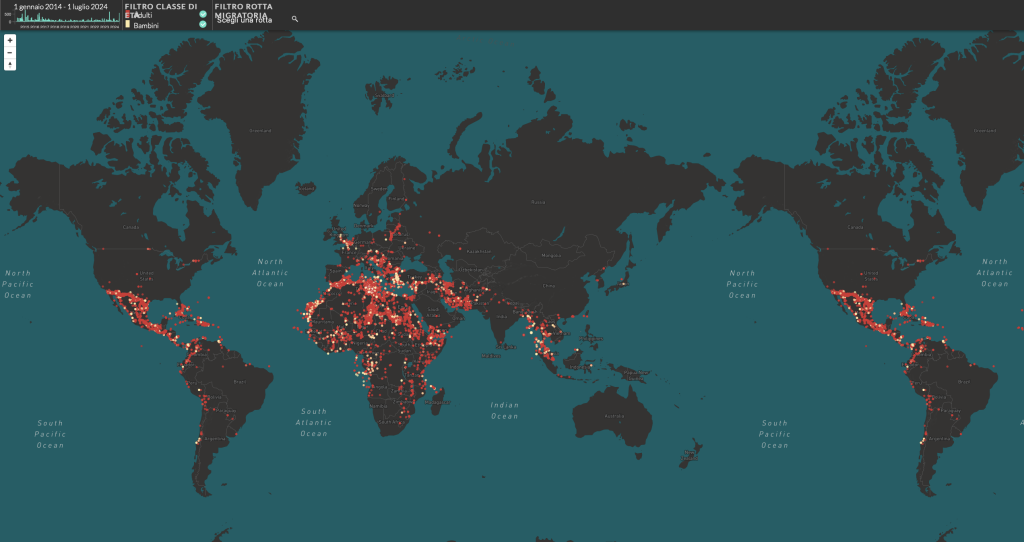
Behind the scenes of the map
Domenico Cangemi, a mathematician and researcher at the Luiss Data Lab, explains the work behind the map: “Everything is based on the database we download from the Missing Migrants Project, which is updated daily. It reports incidents involving migrant routes, the coordinates of the incident, the number of people involved, the cause, the region, and often the country of origin. It also includes information on how many adults, children, and women were present, as well as how many survived,” explains Cangemi.
The interactive map, updated to July 2024, visualizes information through various indicators: red indicators represent adult deaths, while yellow ones represent children. Cangemi details the map's functionality: “The red dot indicates clusters of incidents, while a square shape represents a single incident with precise coordinates. The larger the square, the greater the number of people involved. Not necessarily all are dead, but the database reports the figure based on deaths or disappearances.”
To ensure the geographic accuracy of each incident location, exact longitude and latitude coordinates are used. However, this requires a data cleansing process, “There’s a long tracking process to verify that these coordinates correspond to the exact location. Geographically, it is very accurate because it gives you the precise coordinate of the incident,” notes Dr. Cangemi.
One of the main challenges encountered in creating the map is managing missing data. “Very often, you are given coordinates but not the incident location. With a database that records almost 17,000 incidents, it is not possible to manually check everything,” says Cangemi. To solve this problem, a machine learning algorithm was developed, which, based on the missing data, analyzes the nearest data with the marked location and attributes the most frequent one.
A growing trend
Riccardo Noury, spokesperson for Amnesty International Italy, warns that 2024 could be even more deadly than 2023: “There’s an escalation. The most underestimated phenomenon, however, is the dead in transit, i.e., the missing at sea. People who die during the internal journey, even before reaching the departure point, let alone the arrival, are already dead.”
Professor Francesco Cherubini, an expert in international law and migration at Luiss, provided a detailed analysis of the main legal issues regarding the management of migration flows in the Mediterranean and the Balkans, based on data from the Luiss Data Lab Migrant Map. According to the professor, one of the most relevant issues is the conditions of entry into the Schengen area for third-country nationals: “In particular, having a visa is a crucial but discretionary requirement that many migrants fail to meet. This forces them to turn to traffickers who offer illegal routes by land or sea, often more dangerous and expensive than legal flights. International regulations could improve migrant protection during their journey by intervening in legal entry channels and dismantling trafficker networks that often extend to the exploitation of the migrants themselves. However, the challenges are many, including cooperation with transit and origin countries.”
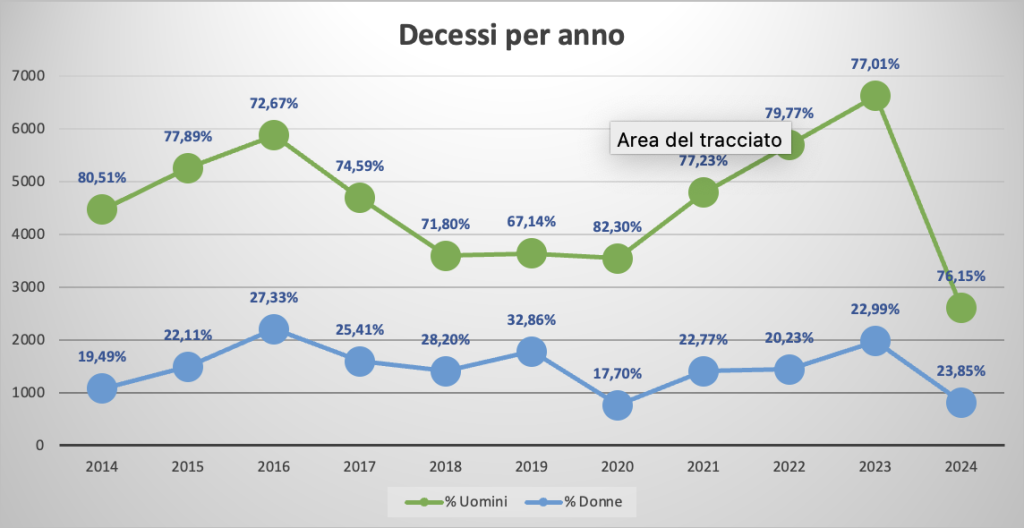
Mediterranean: the massacres of 2023
“The worst massacres in the Mediterranean date back to last year, with tragic events like those in Pylos and Cutro. The reason for such high numbers is due to closure policies, outsourcing agreements, NGO criminalization, or administrative detentions of ships. This not only discourages departures but makes them more dangerous and deadly,” explains the spokesperson for Amnesty Italy, recalling the two major shipwrecks where 94 people, including 34 children, died off Cutro, and 600 in Greece. “When you remove rescue ships and people die, there’s a correlation between the number of deaths and the denial of rescue policies,” concludes Noury.
Regarding the criminalization of NGOs involved in rescuing migrants at sea, Professor Cherubini clarifies that the organizations operate within international law, which imposes sea rescue: “However, there is a risk of abuse and the possibility of collaborating with traffickers. Such situations must be handled with care on a case-by-case basis. Illegal routes not only expose migrants to extreme security risks but make them vulnerable to exploitation and human trafficking. Traffickers are often involved in broader exploitation and slavery networks in destination countries.”
"The Game": the difficult lottery of migrants in the Balkans
The migration route through the Balkans, known among migrants as “The Game,” represents one of the most difficult and dangerous paths to reach Europe. This term was coined by migrants themselves to describe the nearly impossible challenge of crossing the border between Bosnia and Croatia, hoping to reach Italy. Valerio Nicolosi, a journalist and expert on this route, explains in his book ‘Il Gioco Sporco’ how thousands of people attempt this journey, often facing violence and pushbacks by Croatian, Slovenian, and Italian police.
“It’s a route that starts from the Bosnian cities of Bihac or Velika, located in the north of the country, and winds up to Trieste. The journey, which can last up to fifteen days on foot, is made even harder by the tight surveillance of Croatian police forces, acting as border gendarmes for the European Union. These agents not only push back migrants but often mistreat, beat, and rob them, destroying their phones and making communication and navigation impossible.”
Nicolosi describes how the Croatian police have become a real barrier to entering Europe, making “The Game” a sort of lottery where only a few succeed. Some migrants attempt the passage dozens of times before succeeding, if they ever do. The difficulties are aggravated by chain pushbacks involving Slovenia and Italy, with migrants being continuously moved from one country to another, often in inhumane conditions.
Nicolosi highlights that pushbacks also occur in winter: “With temperatures that can drop below zero, increasing the risk of hypothermia and death. Migrants are often forced to pass through icy rivers and mined areas, remnants of the Yugoslav war. The mines, not mapped in detail, represent an additional mortal danger, moving with the rain and snow.”
The journalist also criticizes the so-called “bilateral agreement” between Italy and Slovenia from 1996, revived by former Interior Minister Luciana Lamorgese, which allows Italian authorities to push back migrants into Slovenia within ten kilometers of the border. This agreement, outdated by European law, perpetuates violence and instability along the Balkan route.
According to Nicolosi, the only sustainable solution would be to open legal channels for migrants directly from their countries of origin or neighboring countries, allowing them to apply for a visa and legally access Europe: “This approach would ensure greater safety for both migrants and host countries, avoiding the cycle of violence and pushbacks that currently characterizes ‘The Game’.”
Africa: the internal crisis
In Africa, deaths from drowning, climatic causes, and lack of medical assistance are common: “The movements are mainly internal. From Sudan to South Sudan, from Sudan to Egypt, from Somalia to Ethiopia, and so on. There is a large movement towards South Africa. These are internal displacements largely due to conflicts and the climate crisis making arable land increasingly scarce.”
Professor Cherubini highlights: “Migrations from Africa present unique challenges, often linked to poverty, conflicts, and human rights violations, requiring more effective diplomatic and political pressures to improve conditions in origin and transit countries. – continues – Internal movements on this continent represent an extremely widespread and varied phenomenon. For instance, out of a hundred Nigerians, few undertake the risky journey to Europe, while most move within their country or to neighboring nations. This dynamic underscores a less visible but often crucial reality: most African migrants do not cross the Mediterranean but move locally, contributing to regional socio-economic dynamics.”
The responsibility for managing these migration dynamics mainly falls on the host states. However, ensuring the respect of human rights in this context is a significant challenge. The only effective tool seems to be constant diplomatic pressure for African states to adopt fundamental rights protection standards aligned with international standards.
“Post-colonial legacy still significantly influences African policies. After independence, many African countries saw international efforts to impose Western standards as a new type of colonialism. This has fueled resistance to external interference and further complicated attempts to promote human rights and socio-economic development through international cooperation,” concludes Cherubini.

Asia: the Rohingya route
In South Asia, the Rohingya, an ethnic group persecuted for decades, flee from Myanmar to Bangladesh, and then face maritime routes to Indonesia and Malaysia. Riccardo Noury of Amnesty International explains: “Migrants here face shipwrecks, closed ports, and drifting vessels. Human rights organizations are calling for legal and safe pathways, family reunifications, and the issuance of visas to legalize what is currently illegal.”
The situation of the Rohingya is dire. The human rights crisis in Myanmar has worsened due to military authorities intensifying their repression of peaceful opposition. Since the coup on February 1, 2021, military control has led to human rights violations. Over 4,000 people, mostly civilians, have been killed in indiscriminate attacks.
The maritime route to Indonesia and Malaysia is one of the few remaining options for the Rohingya seeking safety. However, the journey is perilous. Many are shipwrecked, die at sea, or are turned away by the closed ports of destination countries. Even if they manage to arrive, living conditions are not always better, with many ending up in detention camps.
Afghanistan: the refugee crisis
The government of Pakistan has decided to expel foreign nationals without proper documentation from its territory. This measure primarily affects people from Afghanistan, at least 1.5 million individuals, including 600,000 who fled after 2021 following the resurgence of the Islamic Emirate of Afghanistan. "And after the return of the Taliban, millions of Afghans moved to Pakistan. However, when this territory declared migrants irregular in October 2023, thousands were sent back to their country of origin. This led to an increase in deaths during return journeys to the west, along Iran and Turkey, or from drowning at sea." Afghan refugees thus face a dire choice: stay in Pakistan and risk arrest, deportation, and abuse, or return to their homeland, where a humanitarian and economic crisis has persisted for months. Additionally, they must undertake a perilous journey that could still lead to their death.
Mexico: the world's most dangerous land route
In recent years, the border between Mexico and the United States has become the most dangerous land route in the world, as well as a stage for controversial migration policies. According to Professor Cherubini, border management has seen significant changes with the change of U.S. presidents. Trump's policy was known for its anti-migration rhetoric, while Joe Biden continues to navigate an equally problematic, if not worse, context, albeit with less media attention. The U.S. policy of deterring and controlling migratory flows along the Mexican border is historical and persistent. However, recent years have seen an escalation in security and control measures, with the deployment of private patrols to monitor the border. "These patrols have the authority to act autonomously, with the risk of using force against migrants attempting to cross the border. This scenario has led to increased tensions and human rights violations along the border." "U.S. migration policy does not depend solely on the current administration but is a constant that spans different governments. The Trump administration attracted media attention for its hardline policies. For example, during the Italian government of Gentiloni, led by Interior Minister Marco Minniti, one of the most restrictive policies in Europe towards migrants was adopted, despite the public often focusing on figures like Matteo Salvini." Migration policy, both in the United States and Europe, can have significant electoral consequences, decisively influencing electoral support.
Climate Refugees
The correlation between climate change and forced migrations has been studied for several years, but as of 2024, there is still no explicit recognition in international law. The 1951 Geneva Convention and subsequent regulatory provisions have never provided a legal definition for people forced to move due to the direct (desertification, natural disasters, etc.) or indirect (wars over scarce resources) consequences of climate change. Despite the growing attention to the effects of climate change, the status of millions of people who may be forced to relocate due to the climate crisis in the coming years has not been updated. "Time is always ahead of the law. Climate change produces conflicts that, in turn, produce refugees. People don't flee just because of a lack of water but also because of internal conflicts caused by resource scarcity. They flee from extreme climatic conditions and die because of these, but also due to conflicts arising from climate change." According to data collected by the Luiss Data Lab, mortality caused by hostile environmental conditions is around 11% globally. The Intergovernmental Panel on Climate Change (IPCC) predicts that by 2050, 216 million people could be forced to leave their land to survive. Therefore, the issue of climate refugees will be a critical aspect of migrations in Africa. Professor Cherubini comments: "Although there is still no formal international recognition for climate refugees, environmental impact will push more and more people to migrate to escape natural disasters such as floods, droughts, and desertification. These movements are often part of the internal migrations we see on the African continent, adding further pressure on already limited resources and vulnerable infrastructures."
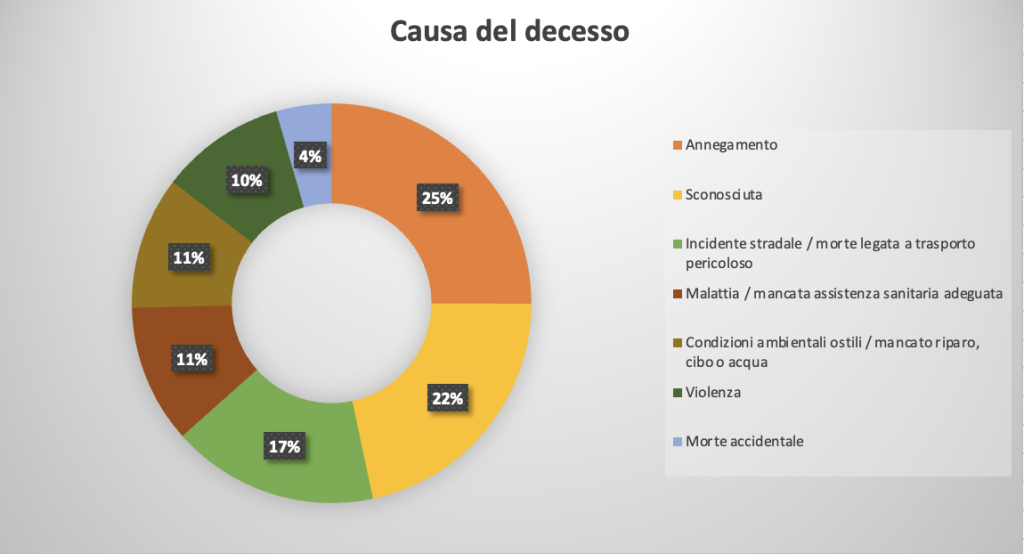
Gender issues
Closure migration policies often force families to send forward the stronger members, generally adult men (around 18-30 years old), more capable of enduring the hardships of the journey and torture. However, entire families also move, especially from Syria. Although men are more numerous and record a higher death rate, women and children are the most vulnerable, often unable to swim, being pregnant, or having suffered sexual violence. Furthermore, gender plays a significant role in African migration dynamics. Professor Cherubini explains: "It is predominantly adult men who undertake the journeys, often due to the risk of political or economic persecution threatening their personal safety. Women, on the other hand, are often exposed to specific risks such as sexual exploitation and gender-based violence, conditions that, although recognized as valid reasons for refugee status, are often not adequately addressed in the socio-political contexts of origin countries."
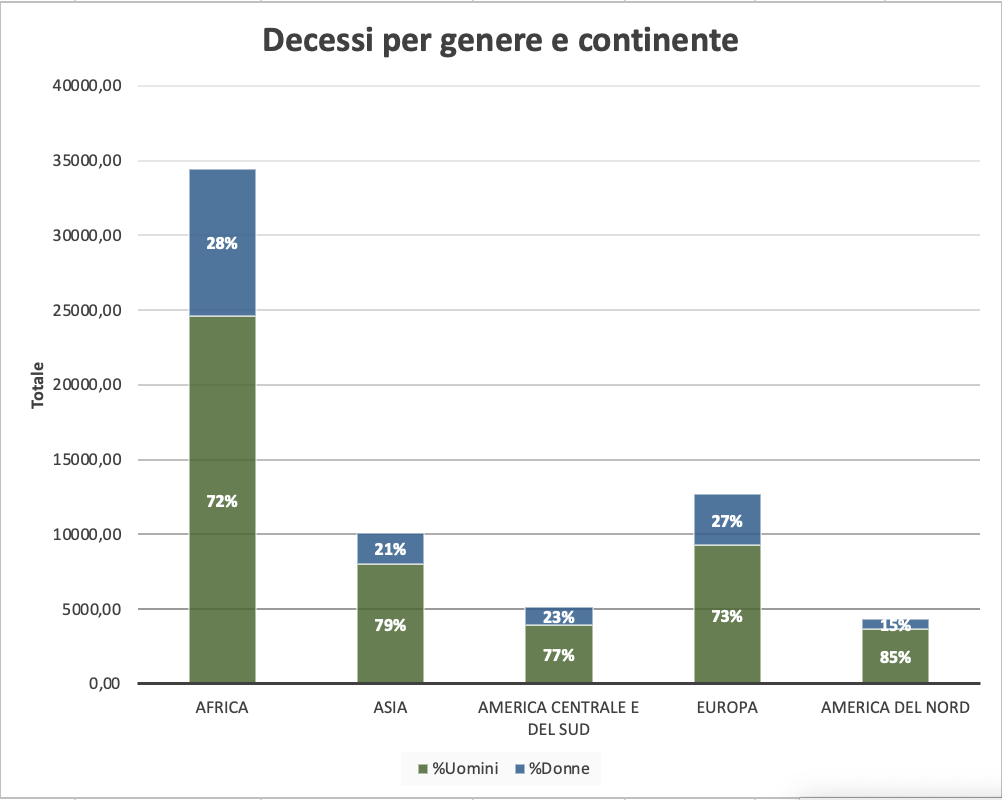
Survivors
Analyzing migratory flows to Europe, one of the most complex issues concerns the accurate estimation of survivors and the dead. According to Professor Cherubini: "The true number of deaths will never be known with certainty. This is particularly true for migrants departing from Libya and Tunisia, where counting those who boarded and subtracting those who arrive might seem a simple method, but it is far from precise." Applications for international protection filed at various landing points are a partial indicator of survivors, but they do not tell the whole story. Many migrants undertake overland journeys, crossing Iran, Turkey, or the Sub-Saharan desert, during which many companions disappear without a trace. Cherubini recalls how migrants' accounts are full of references to relatives or friends who vanished during the various crossings or captivity in Libya. "The Mediterranean Sea itself represents an immense challenge for monitoring. Its vast expanse makes continuous and effective surveillance almost impossible, and a distressed boat can sink quickly, often without being noticed. Sicilian fishermen, for example, frequently report finding human remains in their nets, testifying to the silent tragedy at sea. Determining an exact number of survivors and deaths is extremely complicated, if not impossible."
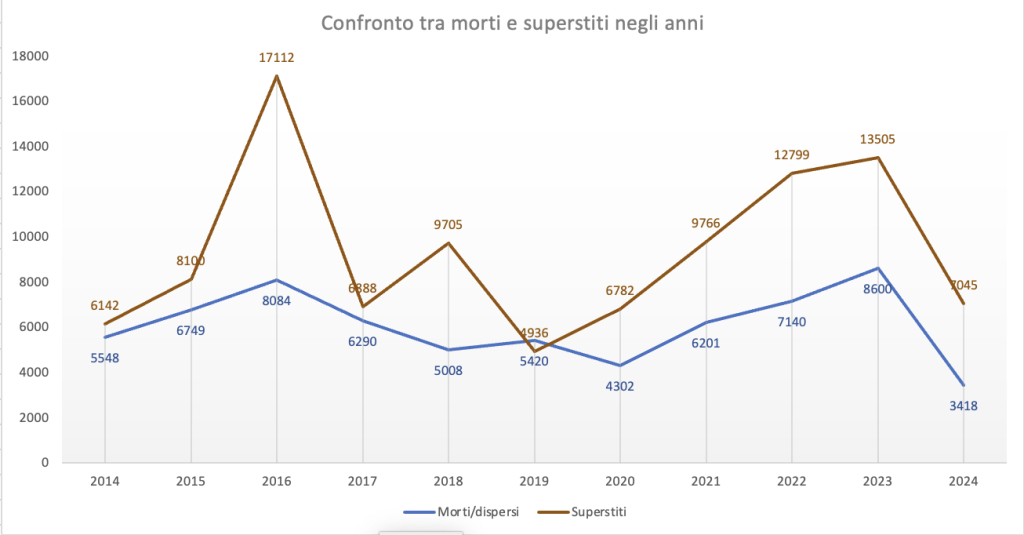
Noury comments: "It is striking that in some years the number of dead and missing is equal to or greater than that of survivors. This means that these people have been completely abandoned to die. The Central Mediterranean remains the most frequented route, but also one of the deadliest in the world. The number of survivors tragically declines in the last year."
For more information: Click HERE to view the map and to read the Italian VERSION of the article
Report by Laura Pace with the support of the Data Lab Team